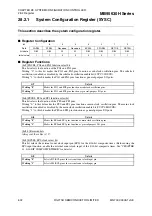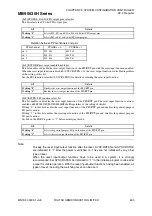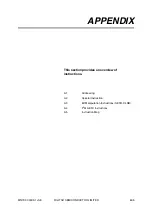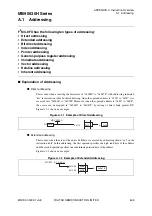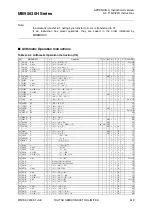
MB95630H Series
MN702-00009-1v0-E
FUJITSU SEMICONDUCTOR LIMITED
613
APPENDIX A Instruction Overview
A.2 Special Instruction
A.2
Special Instruction
This section explains special instructions other than the addressings.
■
Special Instruction
●
JMP @A
This instruction is to branch the content of A (accumulator) to PC (program counter) as an
address. N pieces of the jump destination is arranged on the table, and one of the contents is
selected and transferred to A. N branch processing can be done by executing this instruction.
Figure A.2-1 shows a summary of the instruction.
Figure A.2-1 JMP @A
●
MOVW A, PC
This instruction works as the opposite of "JMP @A". That is, it stores the content of PC to A.
When you have executed this instruction in the main routine and set it to call a specific
subroutine, you can make sure that the content of A is the specified value in the subroutine.
Also, you can identify that the branch is not from the part that cannot be expected, and use it
for the reckless driving judgment.
Figure A.2-2 shows a summary of the instruction.
Figure A.2-2 MOVW A, PC
When this instruction is executed, the content of A reaches the same value as the address where
the following instruction is stored, rather than the address where operation code of this
instruction is stored. Therefore, in Figure A.2-2, the value "0x1234" stored in A corresponds to
the address where the following operation code of "MOVW A, PC" is stored.
●
MULU A
This instruction performs an unsigned multiplication of AL (lower 8-bit of the accumulator)
and TL (lower 8-bit of the temporary accumulator), and stores the 16-bit result in A. The
contents of T (temporary accumulator) do not change. The contents of AH (higher 8-bit of the
accumulator) and TH (higher 8-bit of the temporary accumulator) before execution of the
instruction are not used for the operation. The instruction does not change the flags, and
therefore care must be taken when a branch may occur depending on the result of a
multiplication.
0x12
3
4
A
0xXXXX
Old PC
0x12
3
4
A
New PC
(Before exec
u
ting)
(After exec
u
ting)
0x12
3
4
0xXXXX
0x12
33
A
Old PC
0x12
3
4
A
New PC
(Before exec
u
ting)
(After exec
u
ting)
0x12
3
4




